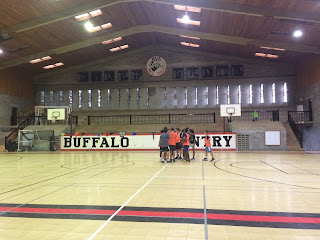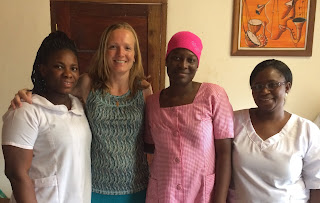After sitting on the sidelines here in Kenya, so to speak, for the first
term (Sept-Dec), I was eager to have my board exam behind me and
looking forward to the chance to be on the team down at the hospital.
Just before we left for the US at the end of November, we had a very
difficult meeting with several people in leadership at the hospital,
wherein I was told that they aren’t going to offer a position to
me: surgical, clinical, or educational. Nothing part-time or
full-time. And yes, this felt like death. Death of yet another dream
for us as a couple on this journey in missions.
It still is raw, and
part of why I haven’t blogged about it or written much in our
newsletter is that I simply don’t want to bring up the feelings
that it created within me, over and over and over. The questions are
inevitable, and I’m struggling to find a concise way to answer and
stop further questions when people ask me, “How do you like working
in Kenya?” and “How are things at the hospital?” and “When do
you start?” and “Have you decided whether you and Ryan are
extending your time past a year?” I have also found that I am
re-dealing with the sorrow of leaving our dream in Vanga, DR Congo. A
counselor reassured me that although we have gotten a great deal of
debriefing about that and felt emotionally stabilized, when something
new comes along that is similar, it can reopen a healing place in our
hearts. And that is certainly what I feel like: raw. Tears come
easily, and I don’t think it is just the pregnancy.
�
I know you may be
thinking, but I have so many questions! How can this be? Isn’t
she volunteering to work as a physician in a hospital for free? Isn’t
the hospital busy? I’ve never heard of this. Aren’t missionary
doctors always overworked? Is this just a temporary ‘no?’ Why
would they not invite her? What is wrong? Where is the
misunderstanding? And I assure
you I’ve been asking myself the same questions. When I get really
down and allow the Enemy to whisper to me, it is usually, “You
aren’t good enough. They
didn’t like you. You
haven’t been able to stay in
one location longer than 14 months so you
aren’t showing perseverance or being patient enough. You
aren’t a good doctor. You
aren’t a good teammate. You
didn’t ask enough questions on
your visit to Kenya last May
and made a mistake.” And I have to fight it. Every. Day.
 |
| A rainstorm in the Rift Valley |
 The
truth is, I don’t resent the hospital leadership, or our
organization, or those who
are working there right now. I am
frustrated by a situation that I don’t fully understand. I’m
upset that when Ryan is finally thriving in his role on the mission
field that I’m not fulfilled. I’m worried our supporters won’t
like to hear that I’m not doing medical work here and
stop supporting us. And I’m
sad to not be a part of a medical team, to not see on a regular basis
our friends who also did the post-residency program with us and are
now permanently here. But… I don’t think I’m supposed to
understand. God was not surprised by this. I can look back at our
Ebenezers and clearly see that we were supposed to come here. I’ve
prayed and prayed for clarity and this ‘no’ is about as clear as
they come. For some reason, I’m not supposed to be working. I’m
supposed to be at home with my kids and have the freedom to come and
go when need be.
The
truth is, I don’t resent the hospital leadership, or our
organization, or those who
are working there right now. I am
frustrated by a situation that I don’t fully understand. I’m
upset that when Ryan is finally thriving in his role on the mission
field that I’m not fulfilled. I’m worried our supporters won’t
like to hear that I’m not doing medical work here and
stop supporting us. And I’m
sad to not be a part of a medical team, to not see on a regular basis
our friends who also did the post-residency program with us and are
now permanently here. But… I don’t think I’m supposed to
understand. God was not surprised by this. I can look back at our
Ebenezers and clearly see that we were supposed to come here. I’ve
prayed and prayed for clarity and this ‘no’ is about as clear as
they come. For some reason, I’m not supposed to be working. I’m
supposed to be at home with my kids and have the freedom to come and
go when need be.
 Before
I start in with some of the good
news, I need to be forthright
that January was a low point
for me. We had just come back from spending time with family after I
finished—and passed—my oral board exam for the final step to
becoming board-certified in OB/GYN. So there was
a natural post-holiday slump. But we brought the dreaded flu back on
our flight home, so about a week after getting back, we were sick,
one after the other, for most of the month. I wasn’t working, but I
had set up our household so that I could have been working, so I felt
like I was simply not needed around
the house. Then I was cooped
up with one kid sick and the other stir-crazy, then I was dog-tired
and pregnant with my own flu, and then the other kid was sick and the
former one stir-crazy. Needless to say, it was a tough start. Ryan
was very busy with a full class load and coaching basketball—and
thriving.
Before
I start in with some of the good
news, I need to be forthright
that January was a low point
for me. We had just come back from spending time with family after I
finished—and passed—my oral board exam for the final step to
becoming board-certified in OB/GYN. So there was
a natural post-holiday slump. But we brought the dreaded flu back on
our flight home, so about a week after getting back, we were sick,
one after the other, for most of the month. I wasn’t working, but I
had set up our household so that I could have been working, so I felt
like I was simply not needed around
the house. Then I was cooped
up with one kid sick and the other stir-crazy, then I was dog-tired
and pregnant with my own flu, and then the other kid was sick and the
former one stir-crazy. Needless to say, it was a tough start. Ryan
was very busy with a full class load and coaching basketball—and
thriving. |
| Ryan enjoying his roles as basketball coach and math teacher |
 |
| Continuing to teach at home |
When
we were on the upswing of sickness, but I was feeling quite
depressed by the situation,
we were contacted by Samaritan’s Purse to see if I could go and
fill an urgent need back in Togo where we just left in June. Ryan
encouraged me to pursue it. I
looked at the calendar and considered what activities were going on
at the school and what I’d already committed to as far as
volunteering for things like nursery duty and hosting students. I
decided that even though the need was for the entire
month of February, I thought, I could only commit until Feb 14. I
sent an email, not realizing that the Togo team had already sent me a
message saying that my end date should be…. you guessed it,
February 14. It was a confirmation to me that the Lord was behind
this. “Whether you turn to
the right or to the left, your ears will
hear a voice behind you, saying, ‘This
is the way; walk in it.’” Isaiah 30:21
NIV
Less
than a week after booking tickets, Sydney and I were landing in Togo.
It was a bit of déjà-vu.
We
had also booked our tickets less than a week in advance when we moved
from Congo to Togo last time. As we left the baggage claims, went
through customs, and exited the airport in
Togo,
the first person that I saw was an airport employee who sort of ran
up to me saying, “Oh Doctor, you are back! I need to come see you.”
To me, this was like getting a big hug from God Himself
as I was dealing with self-doubt. There
were lots of happy reunions over the next few days. The maternity was
significantly less busy than when I had left, a purposeful scaling
back of services due to the shortage of doctors. I
had heard that the numbers of deliveries were down to about 20/month.
Even
so, the moment I walked into the labor room I was able to assist in a
delivery. Another
hug from God.
 |
| Part of the maternity team in Togo |
I’m
trying to settle into a new expectation for this season. I have a
group of students I meet with on Sunday mornings, I am starting to
see formal and informal consults for students and other staff who
want help with medical issues, and I am working on editing a medical
book meant for health workers in developing countries. In the near
future, I’m hoping to help out with menstrual issues and eating
disorders at student health. I’ve even just recently been chosen to
help with a resolution by this year’s Model United Nations
regarding menstrual health hygiene. Of course, I help out with
preschool and run around with my kids. It’s a beautiful climate to
live in, and there are lots of things to be thankful for. But, for
now, the issue of our future and work in the hospital is raw. God
knows and I feel His love in the midst.








